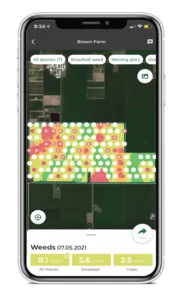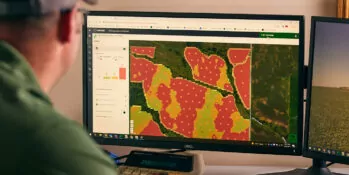

Artificial Intelligence (AI) tools abound in all aspects of our lives. Our fields are no exception, as AI is finding its way into farm machinery and crop management systems. Over the years, the evolution of Precision Agriculture tied into technological advancements, starting in the 1990s, when farmers began using GPS technology to create detailed maps of their fields. Since then, new technologies emerged and improved, allowing farmers to collect and analyze more data about their crops and fields, and make more informed decisions about managing their operations.
AI is changing the conversation.
This is the first blog in a series where we will discuss AI technology and how to apply it to Precision Agriculture methodologies and how, ultimately, AI can take your farm to a new level of efficiency and prosperity.
This blog series is based on Taranis’ recent white paper, Agriculture and Artificial Intelligence: How to Effectively Implement AI in Precision Agriculture.
Before we delve in, let’s set the groundwork for the conversation and better understand what AI is:
These concepts are the foundations of AI functionality, and we’ll come back to these ideas throughout the blog series.
Precision Agriculture has been around for approximately 30 years. As opposed to looking at a farm as one unit, Precision Agriculture told us to look at areas of the farm as distinct groups with different needs. This approach to farm management uses data and technology to help growers make calculated and precise crop management decisions based on the specific conditions of their farm.
 Precision Ag technologies may include soil maps, yield monitors, yield maps, variable rate technologies (VRT), auto-steer and guidance systems, unmanned aerial vehicles, and satellite imagery. Using such technologies, growers can collect and analyze data on key factors such as soil conditions, weather, and crop growth, and make informed decisions about planting, fertilizing, pest management, and harvesting. The purpose of Precision Ag is to optimize the use of inputs, enhance soil health, accelerate decision-making, and increase crop yield.
Precision Ag technologies may include soil maps, yield monitors, yield maps, variable rate technologies (VRT), auto-steer and guidance systems, unmanned aerial vehicles, and satellite imagery. Using such technologies, growers can collect and analyze data on key factors such as soil conditions, weather, and crop growth, and make informed decisions about planting, fertilizing, pest management, and harvesting. The purpose of Precision Ag is to optimize the use of inputs, enhance soil health, accelerate decision-making, and increase crop yield.
Although its benefits are copious, until recently, most US farmers did not adopt Precision Ag technologies. According to a USDA study, adoption rates are increasing over the past two decades, hovering around 30-50%, and vary based on crop type, farm size, and technology. The larger farms, specifically corn and soybean, have higher adoption rates.
What is preventing widespread adoption of Precision Ag technologies?
Some impediments are the high initial costs of certain technologies, doubts pertaining to ROI, lack of sufficient market education, perceived technological complexity, and deficient internet access in some areas.
AI systems play an important part in facilitating the increased adoption of Precision Ag technologies.
Here are a few ways AI applications can improve productivity and yield:
Robotics and automation powered by AI, like autonomous vehicles, sprayers, irrigation systems, and harvesters, can reduce labor costs and increase efficiency.
Crop Intelligence, including images analyzed by AI tools, can increase the grower’s knowledge of their crops, avoiding issues like unnecessary input application and widespread disease infestation.
Supply Chain Management can be improved by utilizing AI to optimize logistics and distribution, including predicting demand and managing inventory.
Crop and Livestock Management – using AI to monitor and manage crops and livestock, including identifying pests and diseases, can improve feeding, animal health and breeding.
Weather and Climate Monitoring using AI to analyze weather patterns and predict weather events can enhance crop and livestock management.
Precision Ag technology is becoming essential to ensuring the sustainability and profitability of modern farming. Specifically, it presents a viable solution to the challenge of feeding a growing population, reducing operation costs, and decreasing the environmental footprint of agriculture.
As technology evolves, we expect to see further innovations in Precision Agriculture that will help farmers achieve these goals more efficiently.
According to a new report, the AI-agriculture market will grow at a compound annual growth rate (CAGR) of 23.1% from 2023 to 2028. With the advances that AI has made in the past few years, it has the potential to be the driving force behind the next revolution in agriculture.
Stay tuned for our next blog, where we delve into AI tools and algorithms and explain their complex application to agriculture. You can also read the entire white paper here.

In this blog, we will focus on the singular aspects of the agriculture industry that make the application of AI methodologies more complex than in other industries.